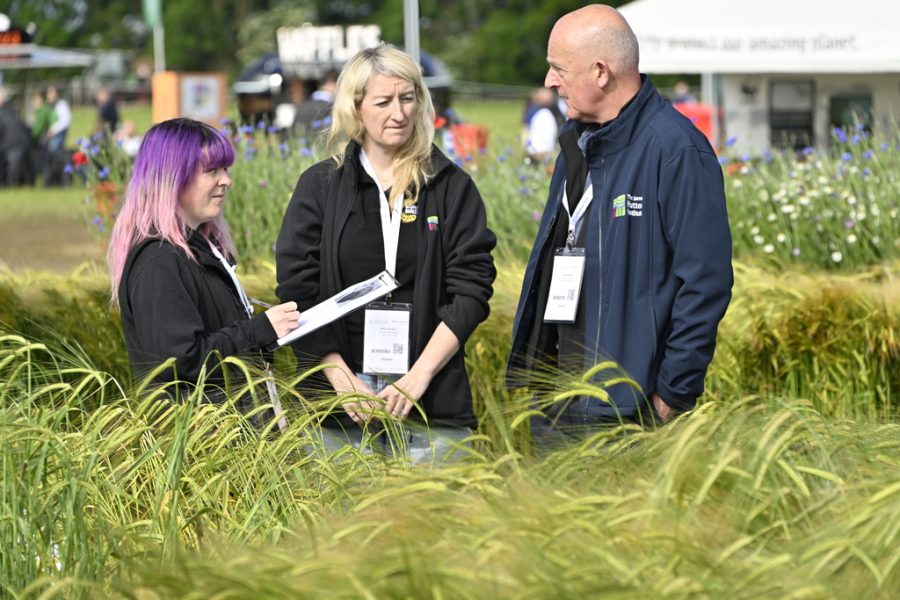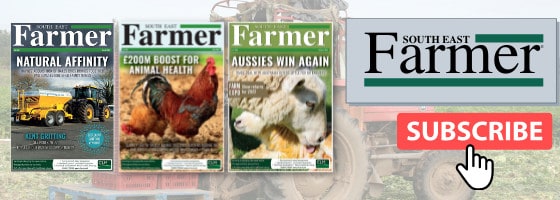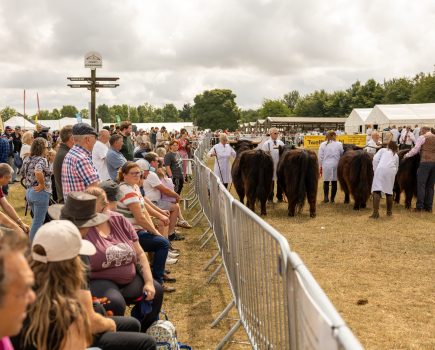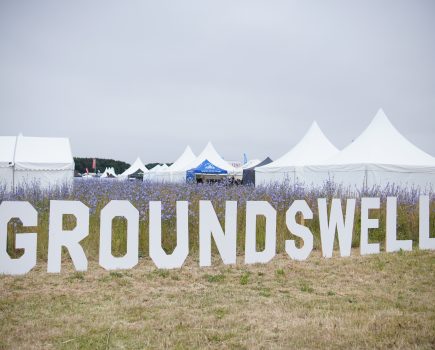Farmers seeking resilient, climate-ready crop options will find plenty of inspiration at this year’s Cereals Event, where more than 600 meticulously curated crop plots will showcase the latest in mainstream and alternative varieties.
The plots, created by 25 leading exhibitors, span everything from drought-tolerant cereals to novel protein crops and improved oilseed rape lines. They offer a hands-on look at the future of UK farming.
Despite the dry spring, the site looked outstanding during the recent Crop Plot Open Day at Andrew Ward’s Heath Farm in Lincolnshire.
“We last hosted Cereals here in 2008,” says Mr Ward. “It felt like the right time to bring the show home; this year’s event truly highlights how innovation in crops and cultivation is evolving to meet new challenges.”
Set across 52 hectares, the event will feature over 400 exhibitors, 200+ live demonstrations, two full seminar days, and hundreds of crop plots covering the latest advances in agronomy, crop science,
However, for Mr Ward, the event is about more than just the latest kit or crop performance. “These shows bring people together,” he said. “Farming is facing big challenges, from market pressures to mental health, and we need spaces where we can talk, share, and support each other. Cereals is exactly that.”
Despite a ‘tricky’ season, Will Davis, partner and agronomist at Ceres Rural, a technical partner of the event, says the site is providing valuable insight for growers. “A wet autumn delayed drilling for many, and now we’re coping with very low rainfall this spring. But this site is forgiving, and we’ve got a strong establishment despite the challenges.”
Ceres Rural is also launching an exciting new Crop Challenge for students, pitting teams from top agricultural universities against each other in a winter wheat growing competition. Judged by Ceres and the AICC, the winning team will be crowned on 11 June, and awarded tickets to the 2026 Cereals at Jeremy Clarkson’s Diddly Squat Farm in the Cotswolds.
“These crop trials are more than just plots,” Mr Davis adds. “They show real-world performance under unpredictable conditions. Whether it rains or not, visitors will gain valuable insights into varietal response and agronomic strategy.”
So, what can visitors expect from the crop plots at next year’s event?
Corteva
Visitors to Corteva’s stand will see the real-world impact of its R&D, from clover-compatible herbicides to disease-tolerant genetics – all designed to boost UK farm productivity and sustainability.
Corteva’s diverse plot features winter wheat, oilseed rape, white clover, and a new Pioneer maize hybrid, showcasing innovation across crop protection and seed development.
A highlight is ProClova, a long-awaited clover-safe herbicide for both new and established grassland. “It fills a major gap in weed control,” says principal biologist Eddie Bardsley. “Growers can now manage broadleaf weeds while retaining valuable clover, essential for livestock and soil health.” Also on show is Prograss, effective against docks, nettles, buttercups, and persistent weeds like hogweed and cow parsley.
In arable systems, Broadway Ultra, a next-gen cereal herbicide, provides strong control of grassweeds like annual meadow grass and a broad weed spectrum, key for modern weed management.
For oilseed rape, Corteva is showcasing resilient varieties with resistance to sclerotinia and verticillium wilt, two damaging and unpredictable diseases. “Built-in resistance offers peace of mind,” says Mr Bardsley.
Pioneer P68106, a new maize hybrid for biogas, forage, or grain, is also debuting. It features strong standing power, early maturity, and high dry matter yields—ideal for UK conditions.
Elsoms Seeds
Elsoms Seeds marks a significant milestone at this year’s Cereals Event, showcasing its largest-ever portfolio with 24 varieties, including new wheats, oats, and pipeline material tailored for UK growers navigating increasing agronomic and market pressures.
Caledon leads the line-up, a newly recommended spring oat that offers a 4% yield advantage over its closest competitor, boosting profitability for margin-focused farms. Building on the success of Bamford wheat, launched last year, Elsoms continues to strengthen its pipeline of high-performing varieties.
Two promising candidate soft Group 4 wheats, Sparkler and Heartwood, will feature in demonstration plots. Sparkler boasts high yields and excellent septoria resistance, while Heartwood offers exceptional untreated disease resistance and early maturity – ideal for regenerative systems and tight rotations.
Also on display is Blackstone, a low-vernalisation wheat allowing late drilling up to February without compromising performance, offering flexibility in unpredictable seasons.
Elsoms will also highlight its Responsive Rotations concept, launched in 2024, which prioritises system resilience over single-season yield. This approach focuses on flexibility, stress tolerance, and diversity, helping growers adapt to changing climate, policy, and market conditions.
“It’s not just end use that defines success,” says Toby Reich. “It’s how well a variety fits your system.”
Grainseed
Grainseed is spotlighting oilseed rape at Cereals 2025, with a strong focus on Pinnacle, the highest-yielding conventional variety on the AHDB Recommended List. Thanks to favourable drilling conditions and lower cabbage stem flea beetle pressure, it has established exceptionally well this season, resulting in clean, well-developed crops.
“Pinnacle is a strong alternative to hybrids, offering comparable yields with added agronomic simplicity,” says Neil Groom, technical director at Grainseed. “It has excellent disease resistance, particularly to light leaf spot; one of the most persistent threats throughout the season, and shows top-end intermediate resistance to verticillium wilt.”
Its robust disease profile makes Pinnacle well-suited to tighter rotations, where disease pressure is more intense, especially from late-season verticillium wilt, which can lead to premature ripening and reduced grain fill.
Grainseed will also preview two new oilseed rape varieties progressing through NL1 and NL2 trials. Early in-house trial results suggest they may exceed Pinnacle in yield, oil content and disease resistance.
Two SFI-compliant seed mixtures will also feature: A one-year legume fallow herbal ley for pollinators and a two-year option for integrated stewardship. Phacelia and wildflower strips will add ecological value and visual appeal.
Limagrain
Limagrain UK is marking its 60th anniversary with a strong line-up at Cereals 2025, showcasing new cereal and oilseed rape varieties bred for resilience, flexibility, and performance in changing UK conditions.
Heather Oldfield, Cereals and Pulses Product Manager, highlights two new Group 4 hard wheats, LG Defiance and LG Challenger, Candidates for this year’s AHDB Recommended List. “These wheats offer excellent disease resistance and high specific weights, showcasing our new direction in multi-gene resistance profiling,” says Ms Oldfield. “They’ve looked outstanding in the ground and in seed multiplication crops.”
Visitors will also see top-performing two-row winter barleys: LG Capital and LG Caravelle. “LG Capital, recommended last year, has shown yields up to 10 t/ha in the East and North,” she adds. “Strong disease resistance and consistent grain quality help growers manage risk in unpredictable seasons.”
Limagrain is also exploring future crop options as UK climate patterns shift. “We’re improving genetics and trialling break crops like peas, beans, OSR CSFB resilience, and sunflowers to find viable, sustainable options for UK growers,” she adds.
On the oilseed rape side, Florentina Petrescu, Oilseed Rape Product Manager, introduces three newly recommended hybrids: LG Adapt, Magelan, and LG Avenger. LG Avenger is the first LG variety to include cabbage stem flea beetle (CSFB) resilience — a novel genetic trait developed to reduce pest damage at key stages.
“This forms part of an integrated pest management (IPM) approach,” she says. “Combined with strategies like moisture conservation, drilling timing, and companion cropping, it gives growers a much-needed edge in re-establishing successful OSR crops.”
KWS is once again presenting its crop portfolio in its signature wheel layout at Cereals 2025, offering a comprehensive view of its latest innovations across winter and spring cereals, oilseed rape, sugar beet, rye, and oats. This year’s spotlight falls on four new AHDB candidate winter wheat varieties: KWS Grebe, Imrie, Fowlmere, and Aintree, each chosen for their standout agronomic traits and market potential.
“KWS Aintree is probably the most exciting,” says Olivia Bacon, UK product manager for wheat at KWS. “It’s a hard Group 4 feed wheat delivering 112% of control yields; an exceptional figure.”
Fowlmere, another Group 4, brings excellent specific weight, while Group 2 newcomers Grebe and Imrie also offer unique traits. “Grebe stands out for its orange wheat blossom midge resistance, which is rare in bread-making wheats, and Imrie has Pch1 eyespot resistance, giving farmers more resilience in high-pressure seasons.”
Disease resistance is a top priority for growers following last season’s high pathogen loads, and KWS’s new introductions are aligned with that demand. “Last year really exposed weaknesses in some varieties, so disease resilience is going to be at the forefront of many farmers’ minds.”
Visitors can also explore a full suite of trait-led varieties beyond wheat, including sugar beet lines with virus yellows tolerance and a variety with Cercospora tolerance, as well as oilseed rape hybrids bred for vigour and reliability.
A new high-protein Group 1 candidate, KWS Vibe, will also be on show. It offers higher protein content than Crusoe and a much better disease package, ideal for quality-focused growers.
Premium Crops
Premium Crops will present various alternative break crops, combining technical and commercial opportunities. Plots will feature high erucic acid (HEAR) and high oleic, low linolenic (HOLL) winter oilseed rape varieties, which command substantial premiums due to robust end-market demand and well-established processing routes.
With contract prices exceeding £600/t, winter linseed is a compelling alternative to OSR. Technically, winter linseed avoids cabbage stem flea beetle risk, requires only 100–120kg/ha of nitrogen (roughly half that of OSR), and faces low disease pressure. Establishment is straightforward, with winter-hardy varieties like Attila performing consistently in Scottish trials.
Modern harvest practices, such as sharp knives and timing for dry days, have mitigated past concerns around linseed harvest. On average, linseed is harvested at or before OSR, helping to spread the workload.
Spring cropping options include spring linseed, red wheat, naked oats, bird seed mixes, and tailored cover crop blends. Many offer attractive market opportunities while supporting soil health and system resilience.
Linseed remains undergrown relative to UK demand, especially for animal feed markets valuing its omega-3 content. With stable pricing, Premium Crops calls for a 25–50% increase in cropped area to meet end-user needs. Visitors can also discuss regulatory challenges facing minor crops.
PGRO
PGRO will feature over 20 trial plots at Cereals 2025, focused on practical pulse crop solutions. Highlights include intercropping trials – like peas with oats or beans – to reduce disease spread and improve land use, plus comparisons of winter beans sown in spring at adjusted seed rates.
Growers can view managed vs. unmanaged fungicide plots to assess real-world impacts on disease resistance, and explore how higher seed rates can maintain winter bean performance when autumn planting is delayed.
Novel crops including winter peas, lupins, lentils, and BYDV-resistant lines will also be display. The DEFRA-funded NCS (Net Zero, Climate Smart) project, involving 17 partners and 200+ farmers, will be spotlighted. It examines how pulses can cut carbon emissions via intercropping, nutrition strategies, and pulse-based livestock feed. Early results from roasted beans show significantgains in protein digestibility, with the project already surpassing early targets.
The digital hub, Pulse PEP (led by ADAS), gives growers real-time research updates and opportunities to contribute insights. Partners will be at Cereals to discuss progress.
PGRO will also present the new ANSWERS initiative, a national bean nutrition study. While no trial plots are planned on site, researchers will be available at the stand.
PGRO’s Alek Ligeza invites grower feedback to shape future research: “Hearing what’s working, or not, is vital. It drives how we adapt, design trials, and return to the data.” PGRO members can also use the free plant clinic service for pest, disease, or establishment diagnostics.
RAGT
RAGT marks a new chapter at Cereals 2025 following the acquisition of the Deleplanque Group, including Strube and Van Waveren. Its stand will feature a widecrop portfolio, from BYDV-resistant wheats and new winter oat varieties to UK-first sugar beet demonstration plots.
“This is new for us as a company, but something we’ve wanted globally for a long time,” says Helen Wilson, managing director at RAGT. Strube brings innovation to sugar and fodder beet breeding, focusing on disease and virus yellows resistance. Richard Cogman, MD at Strube UK, will be available to offer insights into growing sugar beet and resistance management.
Also on display is RGT Goldfinch, a newly recommended BYDV-resistant wheat. Plots will show its performance alongside non-resistant material. “It allows the virus to enter the plant but blocks replication, preventing serious yield losses,” says Ms Wilson. “It’s not absolute immunity, but it’s an essential tool now that seed treatments like Redigo Deter are gone.”
Goldfinch also carries 9s for yellow and brown rust, making it ideal for disease-prone areas. RAGT is also investing in climate resilience, developing waterlogging, salt, and drought tolerance through global breeding programmes for future-ready varieties.
Rothamsted
Rothamsted Research is spotlighting a powerful blend of agricultural heritage and genetic innovation, demonstrating how landrace varieties and modern gene-editing technologies are shaping the future of resilient farming.
Leading the charge is the historic Watkins collection of wheat landraces, assembled in the 1930s and now held by the John Innes Centre. “We’ve only explored about 40% of the genetic diversity in these lines,” says James Clarke, director of communications at Rothamsted Research. “They’re an untapped resource with immense potential, particularly for breeding climate-resilient wheat varieties that can withstand heat and drought.”
New technologies are accelerating the breeding timeline. “We’re monitoring wheat growth 24/7 and using advanced tools like gene editing to zero in on useful traits faster than ever,” he explains. “Given the pace of climate change, we can’t afford to wait; we need these new varieties in farmers’ fields as soon as possible.”
Among the innovations on display are low acrylamide wheat, designed to reduce asparagine, a compound that becomes the potential carcinogen acrylamide when cooked, and high-lipid barley, which boosts nutritional value in animal feed while reducing methane emissions. “These innovations address both food safety and environmental impact – key concerns for food processors and livestock farmers alike,” notes Mr Clarke.
Beyond crops, Rothamsted is showcasing pest control strategies using semiochemicals, harnessing plant-emitted scents to influence insect behaviour. “We’re decoding the volatile organic compounds that attract or repel pests,” Mr Clarke explains. “It’s an elegant approach to pest management with huge potential for sustainable farming.”
Also featured is real-time fungal spore detection technology, delivering on-the-spot diagnostics to improve crop health and productivity.
Syngenta
Syngenta showcases a fully integrated approach to cereal crop production at Cereals 2025, combining new genetics, next-generation crop protection, sustainable packaging, and biological inputs.
The spotlight is on Miravis, a fungicide that consistently delivers yield gains by maintaining green leaf area and reducing crop stress under hot, dry conditions.
A dedicated disease zone will demonstrate integrated management from variety selection through to application timings. The company is presenting SY Cheer, a new Group 1 milling wheat, and two new Hyvido hybrid barley varieties in genetics. SY Quantock, positioned as the successor to SY Kingsbarn, brings grassweed suppression, nitrogen use efficiency, and strong yield potential. SY Kestrel is the first BYDV-resistant winter barley on the UK market.
The 3D90 angled nozzle will be on display, offering 90% drift reduction without compromising coverage or efficacy. It will be accompanied by the Evopac packaging system, which is now widely compatible with EasyConnect. The latter offers faster sprayer filling with a translucent, centre-neck design. Syngenta’s biological line is expanding through NuelloiN and Vixeran, nitrogen-fixing inputs that improve nutrient uptake through foliar or soil applications.
A dedicated area will explore how ‘Every growing day counts’ with biologicals, says Kim Baker, marketing campaign manager at Syngenta Seeds. “By integrating seed, crop protection and agronomy, we help growers get more from every input, in real-world conditions.”
For more information on all exhibitors and their plots, visit www.cerealsevent.co.uk







